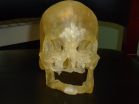(Press-News.org) CHICAGO - Researchers are using computed tomography (CT) and 3-D printing technology to recreate life-size models of patients' heads to assist in face transplantation surgery, according to a study presented today at the annual meeting of the Radiological Society of North America (RSNA).
Physicians at Brigham and Women's Hospital in Boston performed the country's first full-face transplantation in 2011 and have subsequently completed four additional face transplants. The procedure is performed on patients who have lost some or all of their face as a result of injury or disease.
In the study, a research team led by Frank J. Rybicki, M.D., radiologist and director of the hospital's Applied Imaging Science Laboratory, Bohdan Pomahac, M.D., lead face transplantation surgeon, and Amir Imanzadeh, M.D., research fellow, assessed the clinical impact of using 3-D printed models of the recipient's head in the planning of face transplantation surgery.
"This is a complex surgery and its success is dependent on surgical planning," Dr. Rybicki said. "Our study demonstrated that if you use this model and hold the skull in your hand, there is no better way to plan the procedure."
Each of the transplant recipients underwent preoperative CT with 3-D visualization. To build each life-size skull model, the CT images of the transplant recipient's head were segmented and processed using customized software, creating specialized data files that were input into a 3-D printer.
"In some patients, we need to modify the recipient's facial bones prior to transplantation," Dr. Imanzadeh said. "The 3-D printed model helps us to prepare the facial structures so when the actual transplantation occurs, the surgery goes more smoothly."
Although the entire transplant procedure lasts as long as 25 hours, the actual vascular connections from the donor face to the recipient typically takes approximately one hour, during which time the patient's blood flow must be stopped.
"If there are absent or missing bony structures needed for reconstruction, we can make modifications based on the 3-D printed model prior to the actual transplantation, instead of taking the time to do alterations during ischemia time," Dr. Rybicki said. "The 3-D model is important for making the transplant cosmetically appealing."
The researchers said they also used the models in the operating room to increase the surgeons' understanding of the anatomy of the recipient's face during the procedure.
"You can spin, rotate and scroll through as many CT images as you want but there's no substitute for having the real thing in your hand," Dr. Rybicki said. "The ability to work with the model gives you an unprecedented level of reassurance and confidence in the procedure."
Senior surgeons and radiologists involved in the five face transplantations agreed that the 3-D printed models provided superior pre-operative data and allowed complex anatomy and bony defects to be better appreciated, reducing total procedure time.
"Less time spent in the operating room is better for overall patient outcomes," Dr. Pomahac added.
Based on the results of this study, 3-D printing is now routinely used for surgical planning for face transplantation procedures at Brigham and Women's Hospital, and 3-D printed models may be implemented in other complex surgeries.
INFORMATION:
Co-authors on the study are Maximilian Kueckelhaus, M.D., Kanako K. Kumamaru, M.D., Ph.D., Nicole Wake, M.S., Dimitris Mitsouras, Ph.D., Elizabeth George, M.D., Gerald T. Grant, D.M.D., M.S., Peter C. Liacouras, Ph.D., and Edward J. Caterson, M.D., Ph.D.
Note: Copies of RSNA 2014 news releases and electronic images will be available online at RSNA.org/press14 beginning Monday, Dec. 1.
RSNA is an association of more than 54,000 radiologists, radiation oncologists, medical physicists and related scientists, promoting excellence in patient care and health care delivery through education, research and technologic innovation. The Society is based in Oak Brook, Ill. (RSNA.org)
For patient-friendly information on CT of the head, visit RadiologyInfo.org.
CHICAGO - Hybrid imaging with positron emission tomography and computed tomography (PET/CT) in the pituitary region of the brain is a promising tool for differentiating military veterans with post-traumatic stress disorder (PTSD) from those with mild traumatic brain injury (MTBI), according to a new study presented at the annual meeting of the Radiological Society of North America (RSNA).
The findings also lend support to the theory that many veterans diagnosed with PTSD may actually have hormonal irregularities due to pituitary gland damage from blast injury.
MTBI ...
CHICAGO - Changes in brain connections visible on MRI could represent an imaging biomarker of Alzheimer's disease, according to a new study presented today at the annual meeting of the Radiological Society of North America (RSNA).
Alzheimer's disease is the most common form of dementia. As many as 5 million Americans are affected, a number expected to grow to 14 million by 2050, according to the Centers for Disease Control and Prevention. Preventive treatments may be most effective before Alzheimer's disease is diagnosed, such as when a person is suffering from mild ...
CHICAGO - Some high school football players exhibit measurable brain changes after a single season of play even in the absence of concussion, according to a study presented today at the annual meeting of the Radiological Society of North America (RSNA).
"This study adds to the growing body of evidence that a season of play in a contact sport can affect the brain in the absence of clinical findings," said Christopher T. Whitlow, M.D., Ph.D., M.H.A., associate professor of radiology at Wake Forest School of Medicine and radiologist at Wake Forest Baptist Medical Center ...
(PHILADELPHIA) - Although prostate cancer can be successfully treated in many men, when the disease metastasizes to the bone, it is eventually lethal. In a study published online December 1st in the journal Cancer Research, researchers show that the receptor CCR5 best known for its role in HIV therapy, may also be involved in driving the spread of prostate cancer to the bone.
"Because this work shows we can dramatically reduce metastasis in pre-clinical models, and because the drug is already FDA approved for HIV treatment- we may be able to test soon whether this drug ...
'Tis the season for toys. Children are writing lists full of them, and parents are standing in lines (or tapping on computers) trying to find them. Playing with toys this season or any other is an important way for children to develop, learn, and explore. But anyone planning to buy new toys, or anyone with toys already at home, should know that many toys pose an injury risk to children.
In a first-of-its-kind study, researchers in the Center for Injury Research and Policy at Nationwide Children's Hospital have found that an estimated 3,278,073 children were treated in ...
A breast cancer vaccine developed at Washington University School of Medicine in St. Louis is safe in patients with metastatic breast cancer, results of an early clinical trial indicate. Preliminary evidence also suggests that the vaccine primed the patients' immune systems to attack tumor cells and helped slow the cancer's progression.
The study appears Dec. 1 in Clinical Cancer Research.
The new vaccine causes the body's immune system to home in on a protein called mammaglobin-A, found almost exclusively in breast tissue. The protein's role in healthy tissue is unclear, ...
Nearly 55 percent of U.S. infants are placed to sleep with bedding that increases the risk of sudden infant death syndrome, or SIDS, despite recommendations against the practice, report researchers at the National Institutes of Health, the Centers for Disease Control and Prevention, and other institutions.
Soft objects and loose bedding--such as thick blankets, quilts, and pillows--can obstruct an infant's airway and pose a suffocation risk, according to the NIH's Safe to Sleep campaign. Soft bedding has also been shown to increase the risk of SIDS Infants should be ...
UNIVERSITY OF CALIFORNIA, BERKELEY'S HAAS SCHOOL OF BUSINESS -People may associate political correctness with conformity but new research finds it also correlates with creativity in work settings. Imposing a norm that sets clear expectations of how women and men should interact with each other into a work environment unexpectedly encourages creativity among mixed-sex work groups by reducing uncertainty in relationships.
The study highlights a paradoxical consequence of the political correctness (PC) norm. While PC behavior is generally thought to threaten the free expression ...
Behavioural and drug interventions aiming to prevent people with prediabetes progressing to full blown type 2 diabetes are equally effective for both sexes at preventing progression and reducing weight, according to a new systematic review and meta-analysis. The research is by Dr Anna Glechner, Danube University Krems, Austria, and Dr Jürgen Harreiter, Medical University of Vienna, Austria, and colleagues.
Prediabetes is a general term that refers to an intermediate stage between normal blood glucose control (normoglycaemia) and type 2 diabetes (high blood glucose ...
Using a patient's own rib cartilage (autologous) for rhinoplasty appears to be associated with low rates of overall long-term complications and problems at the rib site where the cartilage is removed, according to a report published online by JAMA Facial Plastic Surgery.
Autologous rib cartilage is the preferred source of graft material for rhinoplasty because of its strength and ample volume. However, using rib cartilage for dorsal augmentation to build up the bridge of the nose has been criticized for its tendency to warp and issues at the cartilage donor site, such ...






